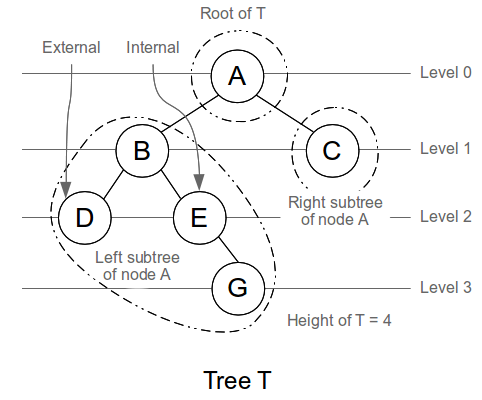- Binary Tree
A binary tree is made of a set of nodes. This set can be empty or it can consist of a node called a root along with two disjoint subtrees. - Disjoint subtrees
Trees that have no nodes in common. - Node
A node contains a value and links to two (binary) other nodes called children (left and right). These links are called edges. A node also might link to its parent node. - Descendant node
Nodes of any subtree are descendants of its root. - Ancestor node
A root of a subtree is an ancestor of it’s nodes. - Path from n1 to nk
The path fromn1tonkis the sequence of nodesn1, n2 ... nk. Where each nodeniin the sequence is a parent of nodeni + 1(each node is a parent of the next / going from the top downwards). - Depth/Level of node M
The length of the path between the root of the treeRandM. The root nodeRis at level0. - Height of a tree
More than the depth of the deepest node in the tree by one.height = max(depth) + 1. - Leaf/External node
A node that has no children. Has neither right nor left subtree.
!hasLeft AND !hasRight = !(hasLeft OR hasRight) - Internal node
A node that has at least one child. Has a right or a left subtree. Or both. An internal node is the opposite of an external node.
hasLeft OR hasRight = !(!hasLeft AND !hasRight) - Full tree
A binary tree which consists of nodes that must satisfy one of the following conditions:- An internal node with two non-empty children.
- A leaf.
Each node must have either
0or2children. Uni-child nodes aren’t allowed. - Complete tree
A binary tree which in which all the levels are full except the last level. You can think of it as a tree that is filled from left to right level by level.
You might confuse a complete tree with a full tree. A little mind trick to memorize them is: the word complete is wider than the word full, so is the complete tree — always wider than the full tree–.
Full Binary Theorem
- The number of leaves in a non-empty full binary tree =
number of internal nodes + 1 - The number of empty subtrees in a non-empty binary tree =
number of nodes in the tree + 1
Proven by mathematical induction.
Traversal
A tree’s nodes are placed in such structure for a reason. We want to process the tree’s nodes — one by one — by visiting them in a certain order.
These ways/orders by which we visit the nodes are called traversals. A traversal on a tree generates a sequence of nodes in which each node appears once and only once. This is called an enumeration.
There are three types of traversal: pre-order, post-order and in-order. They’ll be explained using the following figure.
Imagine you’re starting from the root of the tree and draw a border around the tree parallel to the edges and surrounding each branch as shown.
Whenever you pass through the left of a node, you’re in pre-order. When you are below a node, you’re in in-order. If you are to the right of a node, you’re in post-order.
- Pre-Order
The algorithm goes as follows:
preoreder(node) if(node == null) return; do(node) preorder(node.left) preorder(node.right)
The algorithm goes as follows:
inoreder(node) if(node == null) return; inorder(node.left) do(node) inorder(node.right)
The algorithm goes as follows:
postoreder(node) if(node == null) return; postorder(node.left) postorder(node.right) do(node)
You can do these traversals simultaneously in a more general manner instead of only one at a time by gluing them together. The procedure should looks like this:
traverse(node) if(node == null) return; doPreOrder(node) traverse(node.left) doInOrder(node) traverse(node.right) doPostOrder(node)



